Carroll Pursell, Ph.D.
![]() White
Heat
White
Heat
Carroll Pursell, Ph.D.
People and Technology
- "a collage, rather than a linear narrative. . ."
- "Where careful readers might have expected analysis, they will sometimes find irony."
- "to stress technological meanings more often than methods."
![]()
Temperature at which metal in a forge or oven glows from amber to "white hot."
Introduction | Prehistory | Evidence | Tools as documents | 'A Human Revolution' | Symbolism | Mythic stories | Meaning | Conclusion
![]()
![]()
Objects and artifacts are like art and architecture
in that they each reveal cultural norms, social arrangements, and deep patterns of association.
"… are linked not only because they are all products of technology, but also because each is a symbol invested with meaning."
"Fortunately, tools are rich in meaning. Like any other texts they can be 'read'; careful deconstruction can reveal layers of meanings in their production and use."
"Until recently technology has always been a profoundly conservative activity. It has been too critical a factor in human survival to invite unnecessary and potentially retrograde variations. The ubiquity and stability of the Acheulean hand axe, however, are stunning."
Pursell, p. 18.
Technology shapes and is shaped by
- Tools – implements of human design to accomplish tasks.
- Changes – revolutions in use, design, & purpose.
- Symbols – imaginative elements of human expression from despair to rapture.
- Behavior – the alteration of human actions to meet any device's demands.
- Mastery – an elusive, but important, human assertion of control; an act of will.
- Performances – as a means of communication complex information about use and production
Pursell: a question to answer.
Introduction | Prehistory | Evidence | Tools as documents | 'A Human Revolution' | Symbolism | Mythic stories | Meaning | Conclusion
![]()
The human evolutionary process is tool laden
Humans have no meaning apart from their tool making endeavors.
Ben Franklin: humans are tool using animals. Contrast that with Aristotle who argued that man is a political animal (in that sense a creature of the herd).
Thomas Carlyle "man is nothing without his tools."
 Tools are
texts that we can read -- indeed must be read to understand their importance.
Tools are
texts that we can read -- indeed must be read to understand their importance.
"Technology is an extension of human capabilities; it also projects meaning."
tool laden -- the phrase means that any material history of human cultures is strewn with implements and instruments.
Any tools are things "being made by human hands"
p. 15.
Pursell implies "problem solving" and the coordination of hands, eyes, and brains; are technical skills all requiring forethought.
What sorts of problems do tools solve?
Introduction | Prehistory | Evidence | Tools as documents | 'A Human Revolution' | Symbolism | Mythic stories | Meaning | Conclusion
Neolithic foundations of homo faber: human toolmakers
homo faber, meaning "man the maker" or that humans fabricate things.
"We are left with, almost exclusively, with bones and stone tools. From these we must infer
Acheulean hand axe, remained unchanged for thousands of years.
p.14, & 18.
"handaxe discoveries span an area extending from southern Africa to northern Europe and from western Europe to the Indian sub-continent," according to Ryan Ellsworth (summer 2008) at the University of Missouri, Anthropology Museum.
Note: The earliest hand axes, date to about 1.6 million years ago, from eastern and southern Africa, at sites such as Konso-Gardula in Ethiopia, Olduvai Gorge in Tanzania, and Sterkfontein in South Africa.
Early hand axes have been associated with Homo ergaster (H. erectus) in Africa and Europe. The later ones seem to be associated with both H. erectus and early modern H. sapiens. Acheulean hand axes first associated with the Acheulean site in the Algerian Sahara desert made from quartzite or basalt, and have been recovered from Africa, Europe, India, and (possibly) China.
The tool can be tracked for evidence of human migration patterns:
Go east, ancient tool makers
Hand axe innovators reached South Asia earlier than thought
By Bruce Bower
April 23rd, 2011; Vol.179 #9 (p. 12).Finds unearthed in southeastern India offer a cutting-edge revision of hominid migrations out of Africa more than 1 million years ago that spread pivotal tool-making methods.
Makers of a specific style of teardrop-shaped stone hand axe, flat-edged cleavers and other implements that originated in Africa around 1.6 million years ago (SN: 1/31/09, p. 11) reached South Asia not long afterward, between 1.5 and 1 million years ago, say archaeologist Shanti Pappu of the Sharma Center for Heritage Education in Tamil Nadu, India and her colleagues.
Rather than waiting until around 500,000 years ago to head into South Asia, as many researchers had once thought.
Until now, scientific consensus held that Acheulean tool makers, presumably H. erectus, reached the Middle East at least twice, around 1.4 million and 800,000 years ago, but went no further. H. Heidelberg then took Acheulean implements from Africa to both South Asia and Europe approximately 500,000 years ago in this scenario.
Introduction | Prehistory | Evidence | Tools as documents | 'A Human Revolution' | Symbolism | Mythic stories | Meaning | Conclusion
So what does the unchanging character of the hand axe suggest about tools and tool use:
"a great continuum according to the perceived evolutionary level of their tools."
p. 15
"the
real implications of this behavior began to sink in."
p. 17
speculation about tool use and language went together in the 18th and 19th centuries.
flint stone "knives"
"therefore while homo erectus could produce a single design it was not possible, in the absence of language, to develop new designs."
p. 18.
Why did the hand axe remain unchanged for such an extremely lengthy duration?
Evidence
age species archaeological remains locations 3 mya homo habilis no clear evidence of fire African Rift Valley 1.75 mya homo erectus fire mastery & hand axes Asia & Africa .5 mya homo sapiens stones & cutting edges
Eurasia & Africa homo faber? speaking ability ? "old world"
See also: Ian Tattersall's, Monkey in the Mirror
Introduction | Prehistory | Evidence | Tools as documents | 'A Human Revolution' | Symbolism | Mythic stories | Meaning | Conclusion
Homo faber -meaning-
humankind the tool makers;
humans as fabricators
Creature  |
antiquity | millions of years | cranial capacity |
|
Homo habilis |
Africa |
3.31
mya |
680 cc |
|
Homo erectus |
Afro-Eurasia |
1.75
mya |
800 cc |
| Homo sapiens | Worldwide |
.5 mya |
1450 cc |
Tool items are archaeological evidence for:
| Years ago | findings | Places | events |
|
2,400,000 |
shattered quartz pebbles | Africa | |
|
1,900,000 |
shattered bones | Africa, N, Central, S. | |
|
1,800,000 |
Migration to Asia | ||
|
1,500,000 |
Acheulean hand axe | Africa, Europe, & Asia | |
|
600,000 |
fire | China | |
|
40,000 |
bone filled pits | America populated | interglacial warming |
|
12,000 |
artistic expression | Spain, France, & Africa | end of upper Paleolithic |
|
9,000
|
agriculture | Fertile Crescent | interglacial warming |
|
5,000 |
flint mining (caves) | Netherlands |
Introduction | Prehistory | Evidence | Tools as documents | 'A Human Revolution' | Symbolism | Mythic stories | Meaning | Conclusion
Tools as documents
Reading the tool as a text: what does it mean?
1984 Kim Yal or Langda people of New Guinea, first contact with west, hand ax makers.
1984-1992 end of hand axe craft in Langda villages
What becomes of culture where the knowledge of tool making is lost to the coming generation, or not passed from the older to the younger generation?
Meaning of tools and the behavior they induce.
"...tools are rich in meaning. Like any other text they can be read; careful deconstruction can reveal layers of meanings in their production and use."
p. 14.
"symbolic meaning had now become encoded in material objects."
'A Human Revolution'
"a burst of symbolic endeavor should accompany one of the greatest periods of technological and social innovation."
|
|
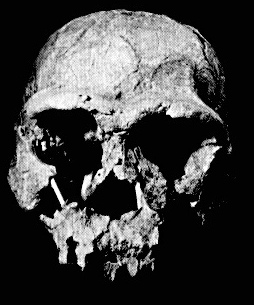 |
"man's total equipment for life." |
"First the raw material was acquired, then it was worked upon, then used for some purpose or purposes, and finally discarded. It is this progression that leads archaeologists to see these tools as both shaping and giving evidence of homo sapiens as social creatures." (p.19) |
|
Skull
of our hominid ancestor |
|
Introduction | Prehistory | Evidence | Tools as documents | 'A Human Revolution' | Symbolism | Mythic stories | Meaning | Conclusion
exaptation is a key concept.
Any range of characteristics (or traits) with an edge today that originally was adapted for other purposes.
Feathers in birds adapted these creatures to loss of body heat, today they assist in flight.
"Is it possible that technology is just such an 'exaptation', evolved originally to enable people to cut meat and chop wood, but available tens of thousands of years later to solve the growing problems of communication? And might it be that our 'abilities', an adaptation of primate brain, might through exaptation enable and explain the evolution of technological 'skills' that continues ever accelerated, into the present?"
p. 27.
Some studies reveal a remarkable relation between the size of a group and the corresponding size of the neocortex in primates.
Introduction | Prehistory | Evidence | Tools as documents | 'A Human Revolution' | Symbolism | Mythic stories | Meaning | Conclusion
What is the optimal size of a group?
| Ancestral sodality | Geography | |||
| nuclear family | extended family | kin | clan | hamlets |
|
3-4 |
5-25 |
26-60 |
150 |
18-200 |
Keeping track of people requires a larger neo cortex.
"Paleotechnical is but a fragment of bio-technics: Man's total equipment for life."
Not for work, not for power, but for life... to live well, to live longer, to nourish one another.
p. 27.
Introduction | Prehistory | Evidence | Tools as documents | 'A Human Revolution' | Symbolism | Mythic stories | Meaning | Conclusion
Technology is fundamentally a cultural expression, as such it symbolizes our values.
Symbolism
"Some anthropologists are attempting to expand this notion of a technological system to include more than just the object and its manufacture by looking at it as a fundamentally cultural expression."
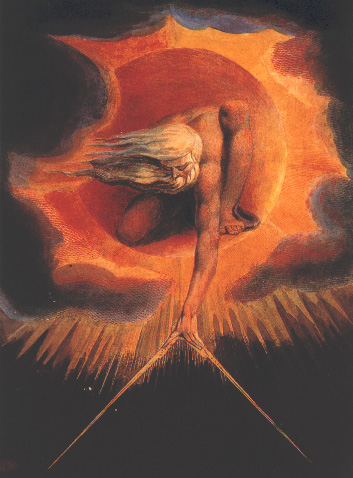 Two images of technology from stories:
Two images of technology from stories:
Promethean or Titanic vs. Satanic or evil
| Promethean |
vs. |
Daedalus |
|
Golom |
&
Icarus |
|
| Faustian |
vs. |
Utopian |
| Frankenstein |
vs. |
Gyro Gearloose |
William Blake's drawing "The Ancient of Days" is of the demiurge, architect of the world from Plato's Timaeus, relief etching with watercolor.
In William Blake's etching here, of the demiourgos, or demiurge, the artist portrays Plato's conception of the creator of the cosmos as the master craftsmen clasps a compass to delineate or mark-out the full scope of the world.
As he is holding the compass in his creative hand, extending the expression of his mind beyond the confines of heaven into the material universe, he inscribes the boundaries of physical existence, which embodies his creation. This is the instrument by which the creator calls into being the universe of which we are participants.
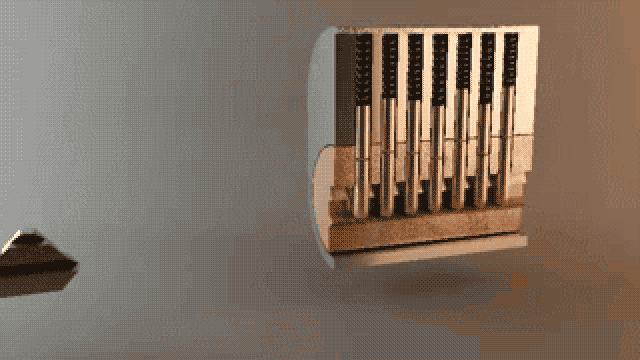 The key is that the world is enabled, if not created, by a tool maker and crafted into existence by the use of these tools.
The key is that the world is enabled, if not created, by a tool maker and crafted into existence by the use of these tools.
Daedalus in Greek means "artful builder."
Introduction | Prehistory | Evidence | Tools as documents | 'A Human Revolution' | Symbolism | Mythic stories | Meaning | Conclusion
Technological Behavior comprises "many elements that make up technological activities" such as:
| 1st element | modes of operation | handcraft, mechanized, automated? |
| 2d element | attitudes towards materials | animal, vegetal, mineral, alloy, synthetics? |
| 3d element | organization of labor | vertically or horizontally integrated? |
| 4th element | ritual observances | protocols, ways of performing, meetings? |
| 5th element | formal relationships | institutional, hierarchical, responsiveness? |
"technologies are performances; they are communicative systems, and their styles are symbols through which communication occurs."
Heather Lechtman, quoted in Pursell, pp. 28-29.
More about the importance of Lechtman's insightful observations in relation to defining technology as a human endeavor of several layers of complexity.
Introduction | Prehistory | Evidence | Tools as documents | 'A Human Revolution' | Symbolism | Mythic stories | Meaning | Conclusion
"It was Aristotle who suggested that every technology had three characteristics: design (or shape [form]. extension), substance (material, and intention, and from the knowledge of any one of these one could make intelligent guesses about the others.
p. 32.
"Indeed intention was at the very heart of technology."
Three ways tools modify – via culturally mediated behavior – our surroundings:
"To try to invent something without any idea of what it is supposed to do stretched credulity beyond limit. The propose might be what archaeologists who deal with a specified period call tectonic (strictly utilitarian), socio-technic, (used to convey social messages), or ideo-technic (used to convey religious or ideological messages) --or in some combination of all three."
Pp. 32-33.
In this sense:
"James Deetz has suggested that our material culture (whether stone tool or family car) is 'that sector of our physical environment that we modify through culturally determined behavior."
"all technology has meaning in the cultural sense, and is not limited to utility."
p. 32-33.
By "not limited to utility" we interpret technology in terms of art, stories, poetry or literary motifs and myths that arise from our imagination.
Introduction | Prehistory | Evidence | Tools as documents | 'A Human Revolution' | Symbolism | Mythic stories | Meaning | Conclusion
Mythological Imagery
Mythic, meaning a story which explains the inexplicable–for example where did the first tools come from? Who invented fire, knives, or glass?
A myth does not mean fake, because it implies a means of understanding how, when, why, and where something exists, myth have value in revealing what we are less than sure about.
Daedalus | Faust | Frankenstein
Compare :the gift of Coyote, the trickster, in American Indian tradition
Prometheus, benefactor and creator of humankind
Aeschylus says of him: "every act was without knowledge until I (Prometheus) came."
"All human science was Prometheus gift."
"the hot radiance of fire" is not worthy of mortals, because it requires vigilance, constant guarding.
Mary Shelley entitled her book
Frankenstein, The modern Prometheus (1830s)
Knowledge without responsibility for the outcome of a finding or discovery. The maker fails to name and fails to adequately educate its creation. She, Mary Shelley, begs the question of who takes responsibility for the products of technical proficiency?
• Why is the God of the forge, fire and craft --Hephaestus-- or Vulcan, crippled?
• What does his lameness convey to us?
Does great ability also bring with it an equally grand cost?
The ancient ideal was to bind utility (use) with beauty (attractiveness) in order to service and elevate the senses.
Introduction | Prehistory | Evidence | Tools as documents | 'A Human Revolution' | Symbolism | Mythic stories | Meaning | Conclusion
Shaping behavior | Fusing two divergent traditions | mastery of technical problems | the new fire's demands
Peter Medawar
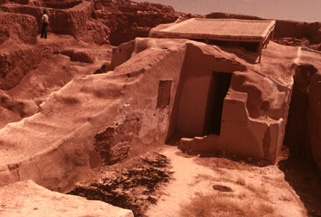 "evolutions
of people and their tools have not only
paralleled each other, but interacted."
"evolutions
of people and their tools have not only
paralleled each other, but interacted."
"all instruments are functionally parts of ourselves"
p. 33.
tools are exo-somatic (beyond our bodies) extensions of our own somatic (bodily) biological endowments.
Remains of cuneiform script tablets were found among these ruins, in one of the oldest library collections in the west; dating to 2300 BCE & discovered in Ebla, Syria.
"Thus as we elaborate our technology we shape ourselves."
The entire "human ambience. the human house... becomes,... a product of human thought."
Oikos or Oikos, household in Greek: root of economy and ecology
forethought (meaning an enlarged, neocortex) is now needed to preserve the human household from deteriorating.
"He was referring to the word 'ecology', taken from the Greek word for household, and he recommended 'forethought' to help preserve it."
p. 34.
Fusing two divergent traditions | mastery of technical problems | the new fire's demands
Consider two ways of misunderstanding technical change are being 1) very optimistic or 2) too pessimistic.
Can we perhaps blend these two?
| Two opposite views of technology and its value: | ||
|---|---|---|
| philic | phobic | |
| 1) wildly optimistic | 2) bleakly pessimistic | |
| Greek myth: | ||
| Daedalus watches as Icarus plunges in this painting of the myth. | ||
| Daedalus flies on wax wings. | Icarus falls to his death. | |
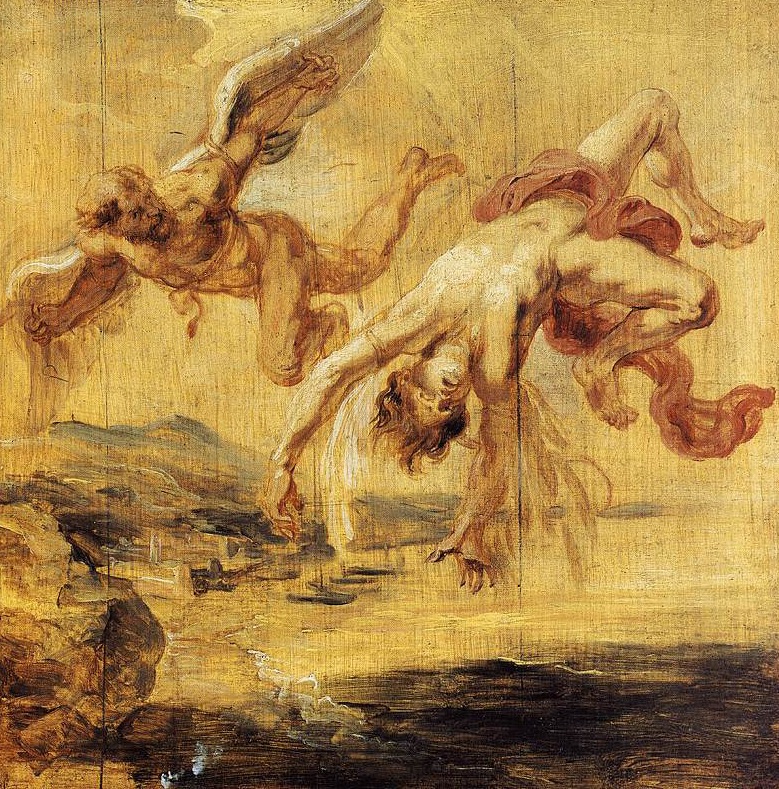 |
||
| Greek heroes: | ||
| terms |
|
|
Deus ex machina |
|
|
| Modern groups: | Frederick Winslow Taylor |
|
| in fiction– | ||
| flaws | ||
Medawar is portrayed as stunningly optimistic vs. Mary Shelley's dubious warnings about irresponsible behavior
This twin tendency, or contradiction in our opinions about the effectiveness of tools to improve our lives, has an ancient origin:
Daedalus, was the artful builder, a mortal creator of the labyrinth at Knossos in Crete, father of Icarus. Daedalean meaning complexly, and cunningly adaptive.
Prometheus, the immortal Titan, bearer of flame and fire's light was punished by Zeus for helping man. Promethean meaning able to achieve enormous advances despite great challenges and crippling costs.
| Prometheus is condemned by the gods to become prey. | ||
 |
||
Twin traditions: |
Daedalean | Promethean |
| artful | titanic | |
| Modern types: | ||
| Technophilia | ||
| Technophobe | ||
Technophobe or Luddite, named for Ned Ludd, who organized English weavers in the 18th century to destroy power looms. Those who dislike innovative technology.
Technophile is a lover of technology, or what we call a booster (from to boost, or promote); that is to say one who always see the positive opportunities in even the worst innovative technology.
mastery of technical problems | the new fire's demands
Introduction | Prehistory | Evidence | Tools as documents | 'A Human Revolution' | Symbolism | Mythic stories | Meaning | Conclusion
Can we master our tools or are these artifacts of human creation, mastering our very ideas and behavior?
Any deliberate combination of collection of various things is a collage; as these images represent a collage of keystone tools or functionally important apparatus in technological systems.
Drivers of technology:
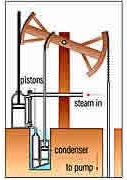 |
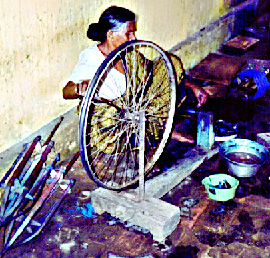 |
 |
| Steam engine | spinning wheel | wagon |
human labor |
human and animal labor |
The driver or trigger is the essential device that spurs the development of many other dependent inventions.
Fission as the ultimate Promethean fantasy fulfilled; because nuclear energy or atomic fire is the today's equivalent of what the discovery of fire was to a prehistoric day.
The source of nuclear fire.
or is fission and what it requires the ultimate Faustian bargain?
Introduction | Prehistory | Evidence | Tools as documents | 'A Human Revolution' | Symbolism | Mythic stories | Meaning | Conclusion
Pacey | Syllabus | Core | Pursell's chapter two | Pursell outline | Pursell Contents
Week Three: Pursell question and the story of Prometheus
Pursell's method | Pursell on technological fallacies
![]()
 |
||
|---|---|---|
| Tools of Toil: what to read. | ||
| Tools are historical building blocks of technology. | ||
Pursell | Pacey | Postman | Head | Eberhart | Tenner | Snow | Kaku